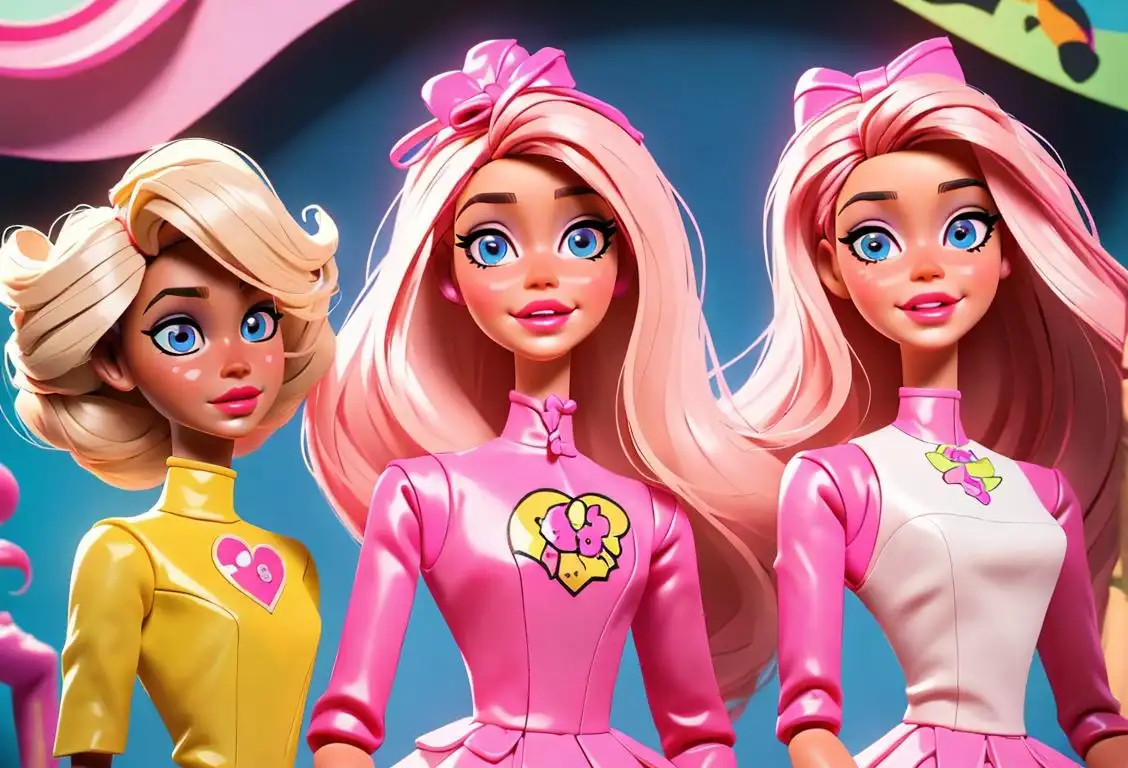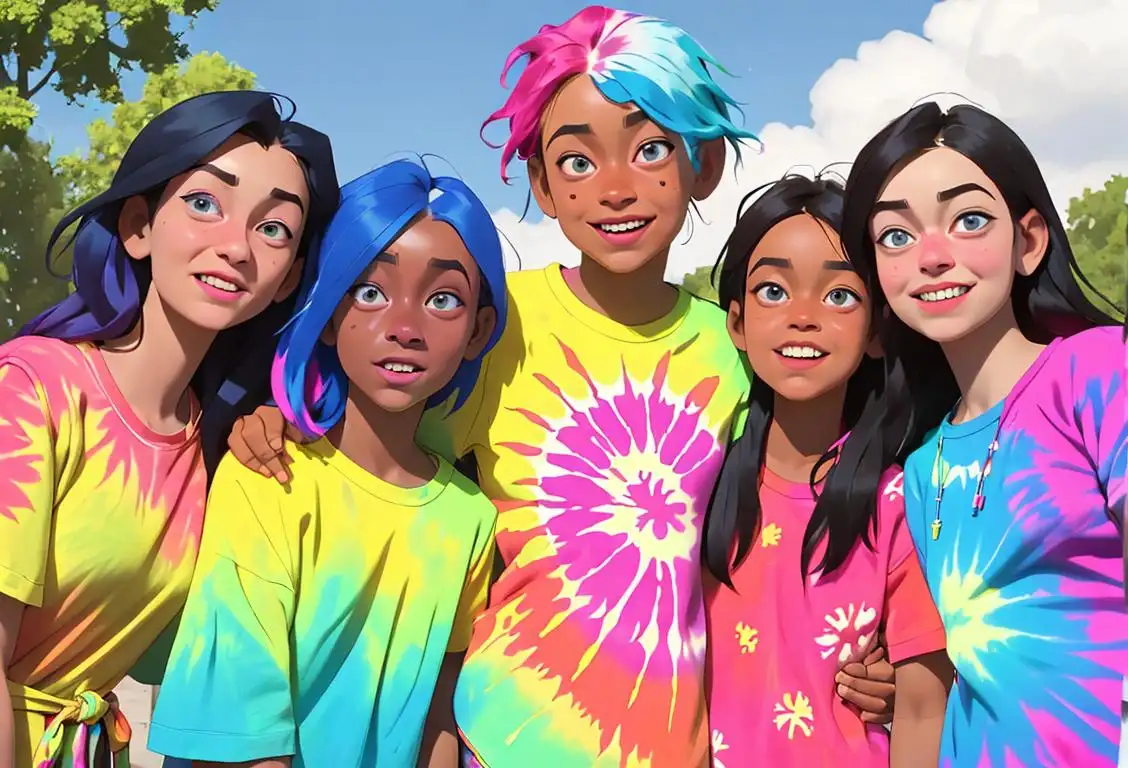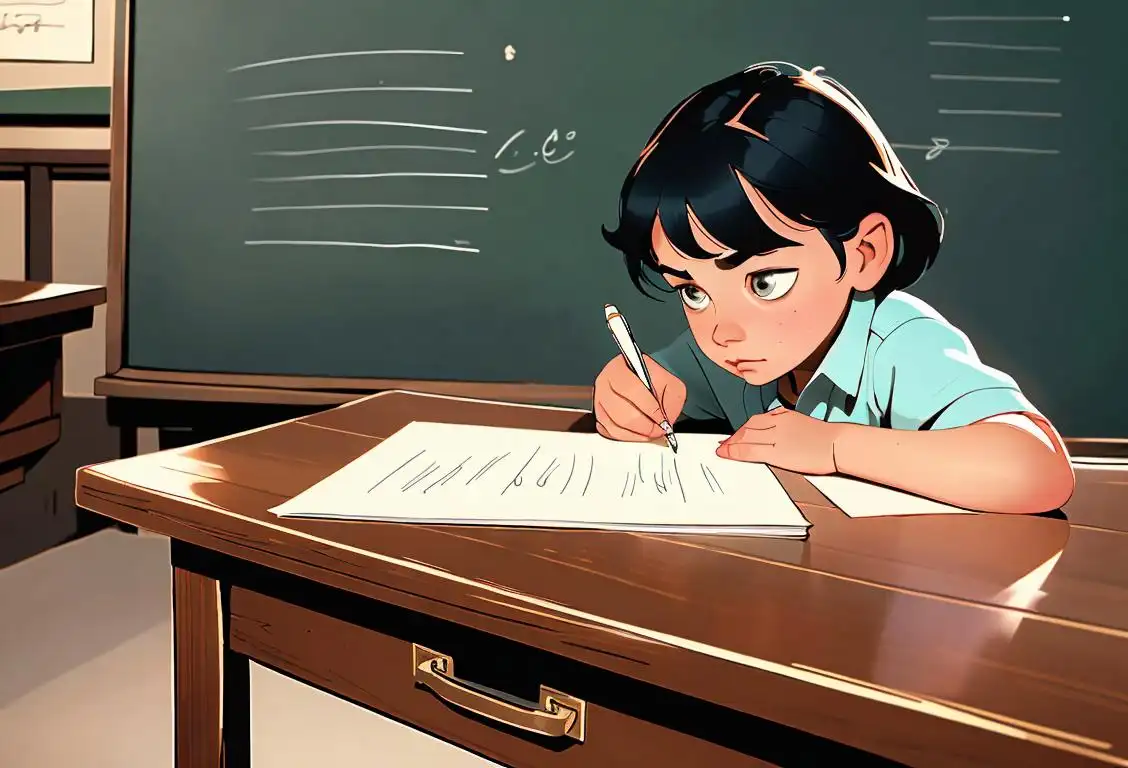National Barbie Doll Day

Hey there, Barbie enthusiasts! Get ready to paint the town pink because it's National Barbie Doll Day! This delightful day celebrates the iconic Barbie doll and all the joy she has brought to countless children and collectors over the years. So, grab your favorite Barbie doll, style her hair, and join us on a trip down memory lane!
When is Barbie Doll Day?
It's national barbie doll day on the 6th September.
The Birth of Barbie
Let's start at the very beginning, a very fabulous beginning indeed. Barbie made her dazzling debut on March 9, 1959, at the American International Toy Fair in New York. Created by Ruth Handler, co-founder of Mattel, Barbie quickly became an instant sensation.
With her slender figure, vibrant fashion sense, and an ever-growing collection of careers, Barbie became an icon of empowerment for little girls everywhere. She showed us that we could be anything we wanted to be, whether it was a doctor, an astronaut, or even a princess. Barbie was a trailblazer, breaking boundaries and inspiring generations of dreamers.
Barbie's Internet Fame
Fast forward to the internet era, and Barbie continues to capture hearts all around the world. Social media platforms like Instagram have become playgrounds for Barbie enthusiasts, where they showcase their impressive collections, create stunning fashion shoots, and even recreate iconic Barbie moments.
Thanks to the internet, Barbie has connected with fans of all ages and backgrounds, creating a tight-knit community of doll lovers. From DIY tutorials to collectors' forums, the internet has provided a digital haven for Barbie enthusiasts to share their love and admiration for this iconic doll.
Did You Know?
Did you know that Barbie has had over 200 careers throughout her existence? Talk about a versatile woman! From being a teacher to an astronaut, a chef to a fashion designer, Barbie has done it all. She even ran for the presidency in 1992, showing us that girls can be leaders too!
History behind the term 'Barbie Doll'
1959
Introducing the Barbie Doll
In 1959, the iconic Barbie Doll was introduced by Mattel, a toy company founded by Ruth Handler and her husband Elliot. Ruth Handler was inspired to create the doll after observing her daughter play with paper dolls, imagining them in adult roles. She believed that girls should have a doll that could represent their future aspirations and inspire their imagination.
1959
The Birth of Barbie
In 1959, the iconic Barbie doll was introduced by the American toy company, Mattel. Ruth Handler, co-founder of Mattel, had noticed her daughter playing with paper dolls and realized there was a gap in the market for an adult-bodied doll. She named the doll after her own daughter, Barbara, and thus, the Barbie doll was born. With her stylish fashion choices and glamorous lifestyle, Barbie quickly became a beloved toy for girls around the world.
1959
The Birth of Barbie
In 1959, the iconic Barbie doll was introduced by Mattel, an American toy company. Ruth Handler, one of the co-founders of Mattel, designed the doll after noticing her daughter's fascination with paper dolls and how she enjoyed giving them adult roles. Barbie's full name is Barbara Millicent Roberts, and she was initially marketed as a teenage fashion model.
1959
The Birth of Barbie
In 1959, the iconic Barbie doll was introduced by the American toy company Mattel. Ruth Handler, one of the co-founders of Mattel, was inspired to create the doll after noticing her daughter Barbara's fascination with paper dolls and her love for adult clothing. Ruth wanted to create a doll that represented an adult woman and aimed to provide girls with a chance to imagine their future selves. The first Barbie doll was unveiled at the American International Toy Fair in New York City.
1959
Birth of a Fashion Icon
In 1959, the iconic Barbie doll made her debut. Created by the American businesswoman Ruth Handler, the doll was named after her daughter Barbara. Standing at 11.5 inches tall, Barbie quickly became a symbol of beauty, elegance, and fashion, captivating the hearts of millions of young girls around the world.
1959
Birth of a Doll
In 1959, the iconic Barbie doll was introduced to the world by a toy company called Mattel. Ruth Handler, one of the co-founders of Mattel, came up with the idea for Barbie after observing her daughter Barbara playing with paper dolls. Ruth realized that there was a gap in the market for a three-dimensional adult doll that could enable children to imagine various roles and aspirations.
1959
Birth of a cultural icon
In 1959, the iconic term 'Barbie doll' was born. The Barbie doll is a fashion doll created by Ruth Handler, co-founder of the toy company Mattel. It was named after Handler's daughter, Barbara. The concept for the doll came to Ruth Handler during a trip to Europe, where she noticed a figurine called Bild Lilli. Inspired by this doll, Handler saw an opportunity to create a more realistic doll for children to play with.
1959
The Birth of Barbie
In 1959, the Barbie doll was first introduced by Mattel, an American toy company. Ruth Handler, one of the co-founders of Mattel, came up with the idea of creating a doll that would allow girls to imagine various career paths and adult roles. The doll was named after Ruth Handler's daughter, Barbara, and thus, the term 'Barbie doll' was born.
1959
Birth of a Fashion Icon
The term 'Barbie doll' originated in the year 1959 when the American toy company, Mattel, introduced a revolutionary fashion doll named 'Barbie'. Created by Ruth Handler, the co-founder of Mattel, Barbie was a plastic doll with a stylish wardrobe that reflected the fashion trends of the time. The term 'Barbie doll' quickly became synonymous with the iconic toy that would go on to capture the hearts of children and collectors worldwide.
1959
Invention of the Barbie doll
In 1959, the iconic Barbie doll was created by Ruth Handler, co-founder of the toy manufacturing company Mattel. Inspired by the paper dolls her daughter used to play with, Ruth Handler saw a gap in the market for a doll that allowed girls to imagine themselves in various adult roles.
1959
Creation of the iconic doll
In 1959, the Barbie doll was introduced by the American toy company Mattel. Ruth Handler, one of the co-founders of Mattel, got the idea for the doll after seeing her daughter play with paper dolls that represented adult women. She realized there was a gap in the market for a three-dimensional adult doll. Thus, Barbie was born.
1959
The birth of a global icon
In 1959, the iconic Barbie doll was introduced by American businesswoman Ruth Handler. Co-founder of the toy manufacturing company Mattel, Ruth was inspired to create a three-dimensional doll that would allow children to play out their dreams and aspirations.
1960
The first Barbie doll
In 1960, the first Barbie doll was introduced to the world. She wore a black and white striped swimsuit, high heels, and had a ponytail hairstyle. With her fashionable clothing and accessories, Barbie quickly became a hit among young girls. The doll was a reflection of the changing times, embracing the fashion and lifestyle of the 1960s.
1961
The First Barbie Commercial
In 1961, the first Barbie commercial aired on television, showcasing the doll's fashionable outfits, accessories, and the various careers Barbie could pursue. This marked an important milestone in popularizing the doll and establishing her as an aspirational figure for young girls.
1961
Expansion of Barbie's Career Choices
Mattel recognized the potential of Barbie as a role model and expanded her career choices in 1961. The first Barbie with a professional occupation was the Registered Nurse Barbie, reflecting the changing social dynamics and women's increasing participation in the workforce. This release marked the beginning of Barbie's diverse range of careers, which later included astronaut, teacher, doctor, and many more.
1961
Expansion into International Markets
In 1961, just a few years after its introduction, Barbie dolls began to gain popularity in international markets. Mattel recognized the global appeal of the doll and introduced her to new countries, solidifying 'Barbie doll' as a term used worldwide. The fashion-forward doll quickly became a symbol of Western culture and influenced the toy industry on a global scale.
1961
Barbie goes international
Two years after its launch, Barbie made her international debut. She appeared in the United Kingdom and immediately became a sensation, winning the hearts of children and collectors alike. This marked the beginning of Barbie's global dominance as a beloved toy.
1961
Debut as 'Barbie'
In 1961, the doll was officially named 'Barbie' after Ruth Handler's daughter, Barbara. The name 'Barbie' became synonymous with the doll and would go on to make a lasting impact on popular culture.
1961
Blond Bombshell
In 1961, Mattel decided to expand the range of Barbie dolls available. The first significant development was the creation of a blonde-haired Barbie, which became the most popular version of the doll. This decision marked the beginning of the trend of offering different versions of Barbie, with various hairstyles, skin tones, and fashion choices, to cater to a diverse customer base.
1961
Expanding the Barbie Family
In 1961, just two years after her introduction, Barbie gained a boyfriend named Ken. The release of Ken marked the first expansion of the Barbie family, allowing girls to create various scenarios and stories for their dolls. With their fashionable outfits and stylish accessories, Barbie and Ken became an inseparable duo in the world of imaginative play.
1965
Barbie's Cultural Impact
By the mid-1960s, Barbie had already become a cultural phenomenon. She represented a new era of independence and aspiration for young girls. Barbie's numerous occupations and roles encouraged girls to dream big and strive for success. Her popularity extended beyond the United States, with dolls being sold in more than 150 countries. Barbie was not just a toy; she became a symbol of female empowerment and a role model for generations of girls.
1961
Debut of Barbie's boyfriend Ken
In 1961, two years after the introduction of Barbie, Mattel launched Ken, Barbie's now-famous boyfriend. Named after Handler's son, Ken became the perfect companion for Barbie and expanded the imaginary world of play for children.
1961
Ken Joins the Scene
In 1961, the Barbie doll got a companion named Ken. Named after Ruth Handler's son, Ken Carson, the Ken doll became Barbie's boyfriend. This addition to the Barbie line aimed to provide girls with more imaginative play options and further expand the doll's world. The introduction of Ken marked the beginning of the Barbie doll's popularity and set the stage for a range of accessories, playsets, and storylines.
1961
The Fashion Evolution
In 1961, Mattel introduced a new accessory for Barbie that revolutionized the doll industry. The company released a line of separate fashion outfits and accessories, which allowed children to dress up their Barbie dolls and create different styles. This innovation brought a new level of customization and playability to the Barbie doll, cementing its popularity and cultural impact.
1961
Expanding Barbie's wardrobe
In 1961, Mattel began to expand Barbie's wardrobe, offering a wider range of fashion options for the doll. This included outfits for different occasions such as parties, weddings, and even careers. As Barbie's wardrobe grew, so did her popularity. Girls could now dress their Barbie dolls in various stylish outfits, fueling their imagination and creativity.
1992
Barbie's Diversity
In 1992, Mattel introduced new versions of Barbie, embracing diversity and inclusivity. Barbie dolls of different ethnicities and skin tones were created, representing girls of various backgrounds. This move was significant as it aimed to reflect the changing demographics and promote inclusiveness. The Barbie brand wanted every little girl to feel represented and empowered by their dolls, regardless of race or ethnicity.
1965
Midge Arrives as Barbie's Best Friend
In 1965, Mattel introduced Midge, Barbie's best friend. Midge was created to address concerns from parents and organizations about Barbie's single status. The addition of Midge allowed Barbie to have a female friend, thereby giving a more wholesome image to the doll. Midge quickly became a popular character in the Barbie world and accompanied Barbie in various adventures and play scenarios.
1965
The Barbie Dream House
In 1965, Mattel unveiled the Barbie Dream House, a luxurious dollhouse designed specifically for Barbie. With multiple rooms, furniture, and accessories, the Dream House became an iconic symbol of Barbie's glamorous lifestyle. The introduction of the Dream House further expanded the Barbie doll's influence and captivated the imaginations of children around the world.
1992
The Anniversary Celebration
In 1992, Barbie celebrated her 33rd anniversary with a range of special edition dolls and accessories. This milestone marked the longevity and enduring popularity of the brand. 'Barbie doll' became a term that represented not only a single toy, but a cultural icon that had influenced generations of children and collectors. The term began to carry connotations of nostalgia and timeless fashion.
1965
Barbie's Boyfriend, Ken
In 1961, Mattel introduced Barbie's boyfriend, Ken Carson. Ken was named after Ruth Handler's son and became a significant character in the Barbie doll narrative. The addition of Ken allowed for imaginative play scenarios, romantic storylines, and further expanded the Barbie brand's reach.
1965
Barbie gets a new face mold
In 1965, Barbie underwent an important transformation. Mattel introduced a new face mold called the 'American Girl.' This updated look brought a more realistic and natural appearance to Barbie's features, reflecting the changing beauty standards of the time.
1963
Baby Steps
Two years after Barbie's introduction, Mattel introduced a companion doll named 'Baby First Step.' This doll had a mechanism that allowed it to take a few steps when prompted. By creating a doll that imitated a baby's developmental milestone, Mattel aimed to give children an even wider range of play experiences and expand the Barbie brand.
1965
Expansion of Barbie's career options
In 1965, Mattel started to expand the career options for Barbie. The company introduced Barbie as a doctor, an astronaut, a fashion model, and many other professions. Barbie became an aspirational figure for young girls, inspiring them to dream big and believe that they could achieve any career they desired.
1971
Barbie's Diverse Range of Careers
By 1971, Barbie had already embarked upon numerous careers, breaking gender stereotypes and promoting female empowerment. Barbie had become an astronaut, a doctor, a pilot, a teacher, and many other professions, encouraging girls to dream big and challenge societal norms.
1971
Diversifying the Doll Collection
Recognizing the importance of representation, Mattel, the manufacturer of Barbie, began diversifying their doll collection in 1971. This year marked the introduction of a Native American Barbie, followed by dolls representing various cultural backgrounds, ethnicities, and professions. This step towards inclusivity ensured that Barbie dolls could resonate with a more diverse range of children and promote inclusiveness through play.
1965
Barbie's evolution
Barbie underwent an exciting transformation in 1965 when her iconic bendable legs were introduced. This innovation allowed children to pose and play with Barbie in more realistic ways, making her even more captivating and versatile as a toy.
1985
Barbie Inspires the Dreamhouse
In 1985, Barbie's iconic Dreamhouse became a reality. The Dreamhouse, a luxurious dollhouse, featured modern amenities, stylish furniture, and even an elevator. This innovative toy provided children with a platform for imaginative play and encouraged them to create their own dream scenarios. The Dreamhouse became an aspirational symbol, sparking the imagination and creativity of young minds.
1980
Diverse representation with the 'Black Barbie'
In 1980, Mattel introduced the first African-American Barbie doll, known as the 'Black Barbie.' This introduction marked a significant step towards diversity and representation in the doll industry. It allowed children to see themselves reflected in the toys they played with and encouraged inclusivity.
2009
Evolution and Diversity
By 2009, the term 'Barbie doll' expanded beyond the original blonde-haired, blue-eyed doll that had dominated the market for decades. Mattel introduced a more diverse range of dolls, incorporating different skin tones, ethnicities, and body types to reflect the evolving world. This pivotal moment in the history of Barbie redefined the meaning of the term, transforming 'Barbie doll' into a symbol of inclusivity and representation in the toy industry.
1971
Diversifying Barbie's world
In 1971, Mattel recognized the need for diversity and launched a line of Barbie dolls with different ethnicities. The introduction of dolls representing different races and backgrounds helped to promote inclusivity and broaden the doll's appeal across cultures.
1980
Barbie's Dream House
In 1980, Mattel introduced the famous Barbie Dream House. This iconic playset allowed children to create an imaginary world for Barbie, complete with a spacious house, furniture, and accessories. The Dream House quickly became one of the most sought-after Barbie accessories and a symbol of Barbie's luxurious lifestyle, influencing generations of children's playtime activities.
2016
Body Positivity and Barbie
Throughout the years, Barbie faced criticism for her unrealistic proportions, which created body image concerns among young girls. In 2016, Mattel responded to these concerns by introducing dolls with different body types, including curvy, tall, and petite. This bold step aimed to promote body positivity and redefine beauty standards for young girls. By offering a diverse range of body types, Barbie became more inclusive and reflective of real women's appearances.
1971
Barbie becomes more diverse
1971 marked a significant step towards inclusivity for Barbie. Mattel released a line of dolls with different skin tones, hair colors, and facial features, reflecting the importance of diversity and representation in playtime. This move helped to cater to a more diverse group of children.
1965
The Barbie Dream House
In 1965, the iconic Barbie Dream House was introduced. It was a luxurious three-story dollhouse complete with modern furniture and accessories. The Dream House became a symbol of Barbie's glamorous lifestyle and offered girls a way to create their own imaginative play scenarios.
1980
Ethnic and Cultural Diversity
As society became more diverse, Mattel recognized the importance of reflecting the world's various ethnicities and cultures. In the early 1980s, Mattel began releasing Barbie dolls that celebrated different ethnic backgrounds. This cultural expansion aimed to promote inclusivity and offer children a wider range of dolls to relate to and play with.
1980
Barbie Goes International
In the 1980s, Barbie expanded her reach globally. With each passing year, Barbie dolls started representing different cultures, ethnicities, and nationalities, showcasing the diversity of the world's population. This step allowed children to learn about and appreciate different cultures and backgrounds.
1971
Malibu Barbie
In 1971, Mattel introduced Malibu Barbie, a doll that embraced a more relaxed and sun-kissed Californian lifestyle. Malibu Barbie featured sun-streaked hair, a beach-ready wardrobe, and a charming smile. This version of Barbie reflected the cultural trends of the time and became immensely popular, reinforcing Barbie's status as a fashion icon.
1971
The First African American Barbie
In 1971, Mattel released the first African American Barbie doll, known as 'Black Barbie.' This milestone marked a significant step forward in promoting diversity and inclusivity in the toy industry. The release of the Black Barbie opened doors for a wider representation of different races and ethnicities in the Barbie doll line, reflecting cultural shifts and embracing the idea of inclusiveness.
1992
Talking Barbie
In 1992, Mattel introduced a talking version of Barbie. This version of the doll featured a small voice chip that played pre-recorded phrases when a button on Barbie's back was pressed. The introduction of talking Barbie revolutionized the interactive play experience, allowing children to engage in conversations and create dialogue-driven narratives with their dolls.
1984
Barbie becomes a pop culture icon
Barbie's influence extended beyond the toy aisle and into popular culture. In 1984, Barbie made her debut in the animated film "Barbie and the Rockers: Out of This World," solidifying her status as a beloved and influential character.
1984
Barbie stars in her first movie
Barbie's on-screen career began in 1984 when she starred in her first animated movie, 'Barbie and the Rockers: Out of this World.' This marked the start of a successful franchise that continues to produce Barbie movies to this day, inspiring creativity and storytelling in young viewers.
2016
Barbie Evolves with the Times
In 2016, Barbie took a significant step towards inclusivity and empowerment by introducing dolls with different body types, including tall, curvy, and petite. This expansion aimed to challenge traditional beauty standards and promote body positivity. By offering a more diverse range of dolls, Barbie continued to adapt to the changing cultural landscape, inspiring children to embrace their individuality and celebrate diversity.
2016
Breaking Stereotypes
In 2016, Mattel released a 'Barbie doll' inspired by Ibtihaj Muhammad, the first American Muslim woman to wear a hijab while competing in the Olympic Games. This remarkable release showcased Barbie's commitment to breaking societal stereotypes and promoting empowerment. The term 'Barbie doll' now embodied the idea of encouraging girls to dream big, challenge norms, and embrace diversity.
1992
Barbie's global influence
By 1992, Barbie had become a global phenomenon, capturing the hearts of children worldwide. She was recognized as an iconic toy and a symbol of fashion and beauty. Barbie's influence extended beyond the toy industry, inspiring movies, TV shows, and even a line of clothing and accessories.
1980
Barbie Empowers Girls with Careers
In the 1980s, Barbie's role expanded beyond fashion and glamour, as she began taking on various careers. Barbie became an astronaut, doctor, pilot, teacher, and many more. These career-focused Barbies inspired girls to dream big and showed them that they could aspire to any profession. The career-themed Barbie dolls became an important tool in teaching girls about different occupations and encouraging ambition.
2020
Barbie's 61st Anniversary
Barbie celebrated her 61st anniversary in 2020. Throughout six decades, Barbie has continued to evolve and adapt to the changing times. She has inspired countless girls to dream, imagine, and explore various career paths. Barbie has become much more than just a toy; she holds a special place in popular culture, influencing fashion, beauty, and even societal perceptions of women. Her longevity as an icon is a testament to her impact on generations and her continued relevance in today's world.
1992
The Birth of Holiday Barbie
To commemorate the holiday season, Mattel introduced the first Holiday Barbie in 1992. This annual limited-edition doll soon became a highly anticipated collector's item. Each year, a new Holiday Barbie is released, usually wearing an elegant gown and embodying the festive spirit. Holiday Barbie dolls have since become cherished items among collectors worldwide.
1992
Barbie's Diverse Makeover
In 1992, Mattel recognized the importance of diversity and inclusivity, and took a major step by releasing a range of Barbie dolls representing different ethnicities. This diverse lineup highlighted the significance of reflecting various cultures and backgrounds, making Barbie dolls more relatable and representative of the global community.
1997
Barbie goes digital
In 1997, Barbie embraced the digital age by launching Barbie.com, her official website. This marked a major step in the evolution of the Barbie brand, allowing girls to engage with Barbie in a whole new way. The website featured games, activities, and even virtual fashion design. Barbie's online presence further solidified her status as a cultural icon.
1992
Barbie's Sculpted Ankles
In 1992, Mattel redesigned Barbie's body, giving her a more realistic look. One significant change was the addition of sculpted ankles, which allowed Barbie to wear flat shoes in addition to high heels. This alteration reflected the growing demand for body positivity and inclusivity in toys, promoting a healthier body image.
2016
Barbie diversifies
In 2016, Mattel introduced a more diverse range of Barbie dolls to reflect the reality and diversity of the modern world. This included dolls with different body types, skin tones, and hairstyles. The move was celebrated for promoting inclusivity and empowering children to embrace and celebrate their unique identities.
1997
Barbie Represents Diversity
In 1997, Mattel unveiled the 'Share a Smile Becky' doll, who was Barbie's wheelchair-bound friend. This release was a significant step toward inclusivity and representation of individuals with disabilities. The introduction of Becky showcased Mattel's commitment to ensuring that Barbie dolls represent the diverse experiences and abilities of children worldwide.
2020
Barbie Celebrates 61 Years
In 2020, Barbie celebrated her 61st birthday, having remained an influential and beloved toy for over six decades. Throughout the years, Barbie has evolved to better represent diverse and inclusive beauty standards, embracing different body types, skin tones, and abilities. She continues to inspire young minds and spark creativity around the world.
2016
Barbie undergoes body diversity update
In 2016, Mattel introduced a new range of Barbie dolls with different body shapes, including tall, curvy, and petite. This update aimed to promote body positivity and celebrate diverse body types, empowering children to embrace their individuality and challenge societal beauty norms.
2016
Barbie's Body Positive Change
In 2016, Mattel introduced a new line of Barbie dolls with different body types, including tall, curvy, and petite. This marked a significant shift in redefining beauty standards and promoting body positivity among young children. The move aimed to inspire self-acceptance and celebrate individual uniqueness, further solidifying Barbie's cultural impact.
2016
Barbie's Body Evolution
In 2016, Mattel made a significant change to Barbie's physical appearance. Responding to criticism about the doll's unrealistic body proportions, Mattel introduced three new body types for Barbie: tall, curvy, and petite. This change aimed to promote body positivity and diversity, encouraging children to embrace different body shapes and sizes. The introduction of varied body types received positive feedback and marked an important moment in Barbie's cultural evolution.
1992
Barbie takes on new careers
To empower young girls and inspire their ambitions, Barbie began exploring various careers in 1992. She took on roles such as doctor, astronaut, athlete, and many more, encouraging girls to dream big and challenge gender stereotypes.
2016
Body Diversity and Customization
In response to growing demands for inclusivity and body positivity, Mattel launched the Fashionistas line in 2016. This line introduced Barbie dolls with different body shapes, including curvy, petite, and tall, along with various skin tones and hairstyles. The new direction emphasized the importance of embracing unique beauty and catered to a more diverse and empowered audience.
2004
Barbie's 45th anniversary
In 2004, Barbie celebrated her 45th anniversary, highlighting her enduring popularity and cultural significance. Throughout the years, Barbie has evolved to reflect societal changes and has remained a symbol of imagination, creativity, and empowerment.
2016
Barbie Embraces Body Positivity
In 2016, to address concerns about body image and unrealistic beauty standards, Mattel introduced dolls with different body shapes and sizes. Alongside the classic Barbie, dolls with curvy, petite, and tall body types hit the shelves. This move aimed to promote body positivity, self-acceptance, and a more inclusive portrayal of beauty. The expanded range of body types allowed children to find dolls that better reflected their own diverse appearances.
2020
60 years of Barbie
In 2020, Barbie celebrated her 60th anniversary. The Barbie doll has remained an enduring symbol of fashion, imagination, and cultural impact for six decades. Throughout the years, Barbie has adapted to societal changes, inspiring generations of children to dream big and embrace their individuality.
2020
Barbie Champions Gender Equality
In 2020, Barbie continued to evolve with the times to champion gender equality. Mattel released a new collection called 'Barbie Inspiring Women,' featuring dolls based on historical and modern-day women who have broken barriers and made significant contributions in their respective fields. These dolls sought to inspire children by highlighting the achievements of real-life role models and encouraging equality and empowerment.
Did you know?
Did you know that Barbie has had over 200 careers throughout her existence? Talk about a versatile woman! From being a teacher to an astronaut, a chef to a fashion designer, Barbie has done it all. She even ran for the presidency in 1992, showing us that girls can be leaders too!Tagged
fun nostalgia fashionFirst identified
10th March 2016Most mentioned on
6th September 2018Total mentions
24Other days
Barbie Doll Day
Nylon Stockings Day
Scrunchie Day
Tie Dye Day
Bell Bottoms Day
Loli Day
Bowlcut Day
Bill Cosby Sweater Day
Comic Book Day
Handwriting Day







